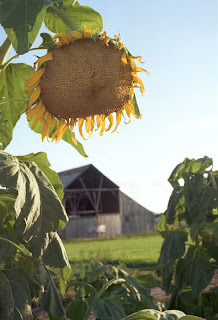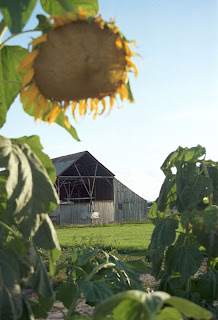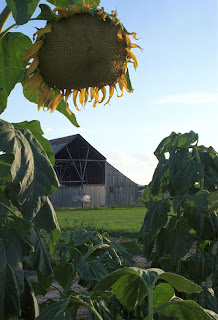
This may be hard to see in such a small image but in this first image posted above the sunflower is in focus and the barn is out of focus. This is accomplished by setting a wide aperture such as a 3.5 or 4.6 and then adjusting the shutter speed to get a good image for light. That shutter speed will usually be fairly fast. Then you focus on the sunflower.

In the image posted above you will notice that the barn is now in focus and the sunflower somewhat blurred. This is accomplished the same was as before only now you will focus on the barn rather than the flower. Remember to set a wide aperture such as a 3.5 or 4.6 and then adjusting the shutter speed to get a good image for light.
 This image is totally in focus and is always fun to do when you have a landscape that you want to be able to see everything in focus. Actually this is the image that you will automatically get from a small camera where you have no control over the aperture and speed settings. This is accomplished by setting the aperture for as small as your lens can allow, usually around a "22". This changes the speed at which the sensor receives light and thus changes the overall sharpness of the image.
This image is totally in focus and is always fun to do when you have a landscape that you want to be able to see everything in focus. Actually this is the image that you will automatically get from a small camera where you have no control over the aperture and speed settings. This is accomplished by setting the aperture for as small as your lens can allow, usually around a "22". This changes the speed at which the sensor receives light and thus changes the overall sharpness of the image. The last thing that will make a difference on whether this works or not is your ISO setting on the camera and whether you have it on a tripod or not. Usually an ISO of 100 or 200 are slow enough to take a picture and get good results for the last image where everything is in focus. If your ISO is up around 400 or 800 then the sensor will in a effect record the image so quickly that you will find it easier to get pictures that are in focus near the camera or away from the camera whichever you want but will be harder to get settings that will get the entire image in focus. It can be accomplished without a tripod but is just easier if you do use one since most of us are not naturally steady holding a camera and will have more of a blurring affect over the entire image. The tripod will make the biggest difference with the lower ISO speeds since that is where camera shake will be seen more easily as the light is being seen by the sensor in effect more slowly.
Now one final note: The best way to get the perfect results that you want is to practice. This is much easier now than it use to be since the cost of film was a major obstacle to taking lots of pictures. Now with digital cameras shoot and shoot some more each time being followed by a careful inspection of your image and preceded by recording what the settings were. Then change and record the settings and try again. You might not want to save all of the images and the delete functions in your computers make that pretty easy to do as well so don't be afraid to practice.



No comments:
Post a Comment